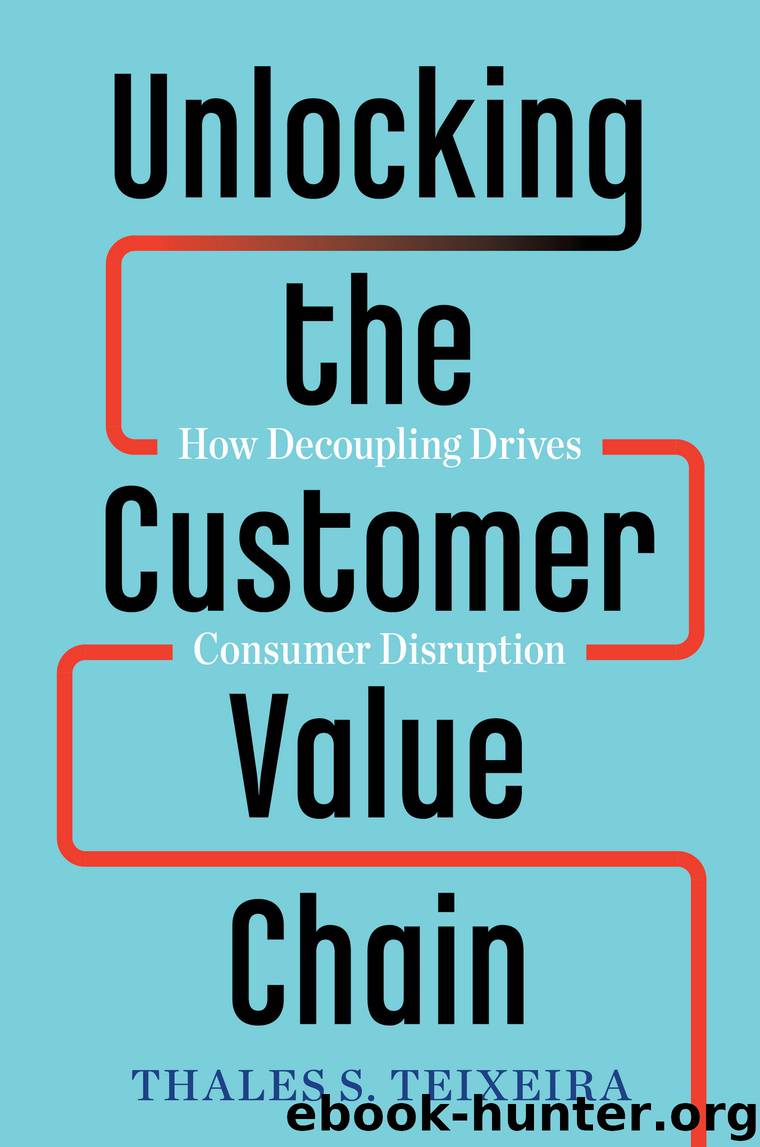Unlocking the Customer Value Chain by Thales S. Teixeira & Greg Piechota

Author:Thales S. Teixeira & Greg Piechota
Language: eng
Format: epub
Publisher: The Crown Publishing Group
Published: 2019-02-18T16:00:00+00:00
FIGURE 6.3 DISTRIBUTION OF SENSITIVITY TO LOAN INTEREST RATES (APR)
Now that we’ve calculated the monetary and effort cost differential for Salary Finance relative to each incumbent, and now that we know customers’ cost sensitivity (that is, what it would take to capture each segment of customers), we can calculate the decoupler’s potential to steal customers away from a given incumbent.
Take Barclays’s medium loan product, with a higher APR rate of 22.9 percent. For a £4,000 loan, customers would pay an annual monetary cost of £916, compared with Salary Finance’s £316. Since it’s cheaper and easier to go with Salary Finance, this decoupler could eventually hope to persuade all but 15 percent of customers—those in the price-insensitive groups. Barclays thus risks losing up to 85 percent of its medium-sized loan business to Salary Finance for employees of participating companies. Given that the bank captured 15.6 percent of market share in 2016, and assuming that its consumer loan portfolio was equally split between medium and large loans, its potential loss amounted to 6.6 percent of the entire market.34 Barclays’s large loans carried a more competitive APR of 4.9 percent versus Salary Finance’s average of 7.9 percent. On the other hand, Salary Finance’s automatic payment via salary deduction made it easier for customers to use. Barclays’s APR advantage of three percentage points will allow it to keep the 15 percent of customers who would never switch, the 14.7 percent of customers who were highly price sensitive, and the 61.7 percent of customers who were somewhat effort (and price) sensitive. Salary Finance would be able to steal only the 8.6 percent of customers who were highly price insensitive and effort sensitive, putting only 0.7 percent of Barclays’s market share at risk.
Obviously, these calculations represent an upper limit of a new challenger’s disruptive potential. In 2016, the United Kingdom’s eight largest banks collectively accounted for 65 percent of the market for consumer loans. Salary Finance’s business model had the potential to steal a whopping 28.9 percentage points of market share. This result owed partially to the lower APR Salary Finance offered compared with large banks (in the case of medium loans for most banks), as well as to the relative ease with which consumers could secure and pay off loans using the service (see Table 6.2).
If you think this potential market share theft is a lot for a single fintech startup to pull off when facing giant incumbents, hold on, there’s more. When I began to talk with Salary Finance, its cofounders were striving to position the startup as a cheaper and more convenient alternative to loans than established banks.*3 In a sense, my analysis put numbers to their intuition. I decided to perform a final analysis, this time adding credit card companies as incumbents. How would Salary Finance potentially impact the card companies’ small-loan business?
Download
This site does not store any files on its server. We only index and link to content provided by other sites. Please contact the content providers to delete copyright contents if any and email us, we'll remove relevant links or contents immediately.
Bad Blood by John Carreyrou(6581)
Rich Dad Poor Dad by Robert T. Kiyosaki(6506)
Principles: Life and Work by Ray Dalio(6296)
Playing to Win_ How Strategy Really Works by A.G. Lafley & Roger L. Martin(6076)
Management Strategies for the Cloud Revolution: How Cloud Computing Is Transforming Business and Why You Can't Afford to Be Left Behind by Charles Babcock(4546)
The Confidence Code by Katty Kay(4217)
Thinking in Bets by Annie Duke(4182)
American Kingpin by Nick Bilton(3812)
Delivering Happiness by Tony Hsieh(3394)
Project Animal Farm: An Accidental Journey into the Secret World of Farming and the Truth About Our Food by Sonia Faruqi(3189)
The Power of Habit by Charles Duhigg(3092)
The Tyranny of Metrics by Jerry Z. Muller(3025)
Brotopia by Emily Chang(3024)
The Marketing Plan Handbook: Develop Big-Picture Marketing Plans for Pennies on the Dollar by Robert W. Bly(3005)
Mastering Bitcoin: Programming the Open Blockchain by Andreas M. Antonopoulos(3005)
I Live in the Future & Here's How It Works by Nick Bilton(2958)
The Content Trap by Bharat Anand(2885)
Applied Empathy by Michael Ventura(2864)
Building a StoryBrand by Donald Miller(2862)
